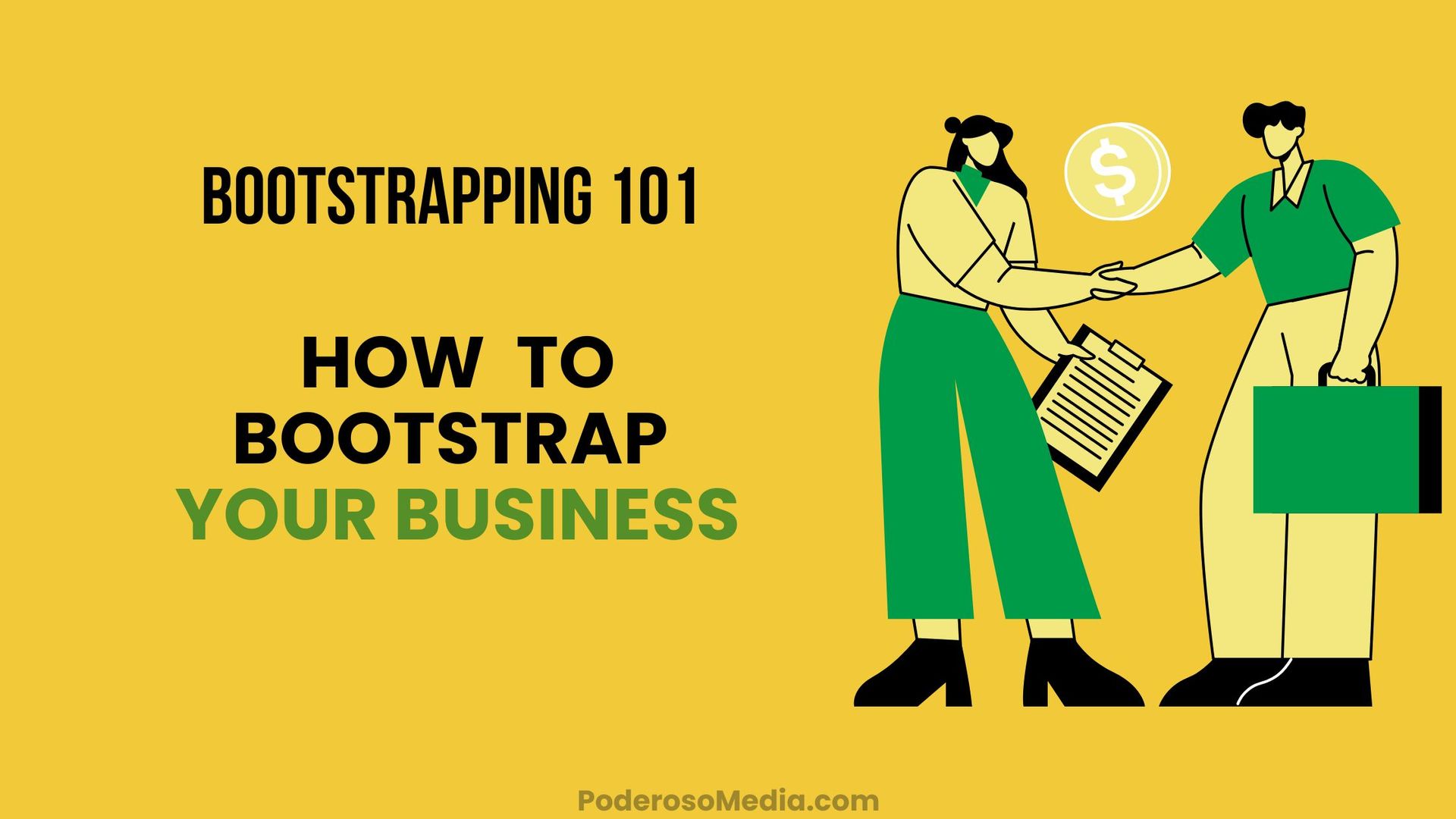
Looking to bootstrap your business? You're in the right place. With a little bit of dedication and scrappiness, you can achieve incredible success even with limited resources by bootstrapping.
The bootstrap method isn't just about saving money; it's a mindset. This mindset requires you to innovate and focus on what matters when building your business.
One of the perks of bootstrapping is that it gives you greater control of the direction in which you want to take your company.
When bootstrapping, every dollar counts, and you learn to stretch resources. The bootstrapping method teaches you to understand your customers, building something they want and need. Without outside funding, there is pressure to get it right from the start.
Let's explore bootstrapping—the strategies, pitfalls, and how to achieve sustainable growth. Whether starting or scaling your bootstrapped business, this guide offers actionable advice. Let's dive in!

What Exactly is Bootstrapping?
Bootstrapping refers to starting and growing a business with your own resources, typically avoiding outside investments from venture capital firms. It's called bootstrapping because it's the pull oneself up by the bootstraps approach to entrepreneurship.
When you bootstrap your business idea, you start free. And I mean literally free. You can choose how to grow your business and where you want to take it because you're not relying on external funding or pressure from investors.
A bootstrap company often use personal savings, sweat equity (a person or company's typically unpaid contribution toward a business venture), and initial sales revenue to fund their operations. This self-funded approach offers founders more control and flexibility.
The Stages of Bootstrapping
Bootstrapped companies typically go through several growth stages, each with its unique characteristics and financing strategies.
There's not exactly a "bootstrapping process," but here's what you can expect:
Beginner Stage
- The founder uses personal savings or small loans from friends and family.
- This stage often occurs while working a day job or engaging in a side hustle.
Customer-Funded Stage
- Initial sales begin to sustain and fuel growth.
- The entrepreneur can transition away from personal finances and reinvest revenue back into the company to grow.
Credit Stage
- The business uses loans, lines of credit, debt, or small investments to fund specific growth initiatives.
- Bootstrapping refers to being clever and creative with financing, finding innovative ways to overcome financial constraints.
By understanding these stages, entrepreneurs can better navigate the challenges of bootstrapping and build a successful, self-sustaining business.
Advantages of Bootstrapping Your Business
Bootstrapping your business offers several long-term benefits.
Maintain Full Ownership and Control
Bootstrapping lets you retain complete company ownership. There's no investor pressure regarding metrics or strategy changes, and you can build as you envision.
Consider Mailchimp, a successful bootstrapped company founded in 2001 by Ben Chestnut and Dan Kurzius without outside funding.

In 2021, Intuit acquired it for $12 billion in cash and stock, one of the largest acquisition amounts for a bootstrapped company.
Forces Efficiency and Innovation
Limited resources encourage creativity. You learn to do more with less and solve problems resourcefully. This becomes a competitive advantage as you grow.
Spanx and business founder Sara Blakely began with $5,000 in savings. She bootstrapped out of necessity after manufacturers and turned her initial pitch down, creating her patent and making prototypes.

Blakely eventually pitched to Neiman Marcus and landed an opportunity to get her product in their stores, laying the foundation for her now billion-dollar company.
Build a Sustainable Business Model
Bootstrapping emphasizes customer focus, prioritizing learning about customers and building a desirable product.
This customer focus fosters sustainable growth and helps you become more adept at solving problems—a solid bootstrapping strategy positions businesses for lasting success without reliance on external funding or capital firms.
Attract Better Investors Later
If you eventually seek funding, a profitable bootstrapped business is attractive to investors because it demonstrates a working business model and execution abilities.
Key Challenges of Bootstrapping
Bootstrapping has its difficulties. Here are some challenges to anticipate:
Limited Resources
The biggest challenge is the need for more capital. You must get creative with resources and might grow slower than venture-backed competitors. You won't have operating revenues to support business activities like funded companies.
Instead, you will have to prioritize funding specific activities. Self-funding your company may also involve taking on personal debt and putting yourself at financial risk if things don't work out.
Wearing Many Hats
Bootstrappers often handle multiple roles—product development, marketing, customer support, and the list goes on. If you're doing this solo, it can be overwhelming and slow progress in certain areas of your company.
Slower Growth
Without substantial capital, bootstrapped companies grow slower initially. You may scale slower than funded competitors, adopting a conservative approach and focusing more on profitability and sustainability over rapid growth and expansion.
Compared to bootstrapped companies, fund companies also have immediate access to a network of investors, mentors, and industry experts who can provide them with guidance and resources.
Meanwhile, bootstrapped founders might have to invest time in developing relationships with investors, mentors, and experts in their industry to gain support and guidance. Even then, it's not guaranteed.
Higher Financial Risk
Bootstrapping your business poses a higher financial risk. You're using your own personal savings and income to fund your business, which may fail, causing you to lose savings, income, and other assets. Be prepared for the possibility of failure.
Strategies for Successful Bootstrapping
Despite the challenges, these strategies can help bootstrappers succeed. A company becomes successful through strategic business management. There are lots of good reasons to pursue a bootstrapping strategy.
Focus on Revenue-Generating Activities
Prioritize activities that quickly bring in revenue.
This can look like:
- Customer Acquisition & Retention: Acquire new customers and retain existing ones through content marketing, email marketing, referral marketing, and customer success.
- Product Development & Sales: Develop and launch products or services that solve real problems for your customers. This includes launching an MVP, upselling and cross-selling (offering complementary products or services to increase value), and optimizing pricing to maximize profitability.
- Partners & Collaborations: Create strategic partnerships to expand your reach through partnerships, affiliate marketing, and joint ventures.
Keep Costs Low
Find ways to minimize early expenses:
- Work from home or use co-working spaces for an office.
- Hire freelancers and contractors instead of full-time staff.
- Utilize free or low-cost software.
- Consider bartering services with other startups and companies for marketing and advertising or other services.
Build a Strong Network
Your network can be a valuable asset. Seek mentors, advisors, and other entrepreneurs. They can provide guidance and support, and even potential customers. A successful business relies on collaboration.
Leverage your existing personal connections. You may have a graphic designer friend who can help with branding and design or a journalist friend who can provide PR.
Focus on Customer Development
Understand your target customers and their needs. Use customer interviews, surveys, and focus groups to validate ideas early. Business owners who understand their customers often experience business growth.
Reinvest Profits for Growth
As revenue comes in, reinvest it into the business to fuel growth rather than taking a large salary.
Case Study: GitHub's Bootstrapped Journey
GitHub is a bootstrapping success story of a software development program that started as a weekend project.
Initially, the founders, Chris Wanstrath, Scott Chacon, Tom Preston-Werner, and P. J. Hyett, kept their day jobs, building GitHub during their off-hours.
They self-funded everything. Even when transitioning to build GitHub full-time, the founders continued to self-fund the company with money from their own pockets.

This enabled years of organic, profitable growth before external funding. By the time they sought investment, GitHub was already thriving.
In 2018, Microsoft bought and acquired GitHub for $7.5 billion.
Tools and Resources for Bootstrappers
Numerous tools and resources can help bootstrapped entrepreneurs. I recommend you check out the best start-up tools for founders in 2024 for an in-depth list.
But in the meantime, check out these handy tools:
- Website Building: Shopify, Wix, Duda, WordPress.
- Marketing: MailChimp, Canva, Buffer, Metricool, Hubspot.
- Accounting: Wave, Quickbooks, Xero.
- Project Management: Trello, Asana, Notion.
- Customer Support: Zendesk, Intercom, Freshdesk.
When to Consider Outside Funding
A few reasons to consider outside funding for your company:
- You need capital to scale or enter new markets. When starting a successful business, how you plan to obtain funds is an important question.
- You're in a competitive space where speed matters. Venture capital can rapidly accelerate growth.
- You've validated your model and are ready for rapid expansion. Consider obtaining funds from venture capital. When pursuing this kind of external funding, your business takes careful planning and consideration.
Funding isn't a magic bullet. Have a clear growth plan for using the capital. Bootstrapping a company relies more on a founder's abilities than seeking investments from a venture capital firm.
A business plan should address whether the company will use outside funding or be self-funded. If you'll eventually require outside funding, it's best to identify that early on to be attractive to VC firms down the road.
Start Your Business Bootstrapping Journey
Bootstrapping is a challenging yet rewarding path emphasizing essentials, customer understanding, and sustainable models. This approach builds stronger, more resilient companies that are better equipped to thrive in the long run.
Bootstrapping isn't just about being frugal; it's about ingenuity and strategic financial management, making intentional and strategic decisions to grow your company creatively.
Just like the legendary stories of...
- GitHub: Born out of a simple weekend project, Github has become a household name in the software development world.
- Spanx: With just $5,000 of her personal savings, Sara Blakely turned her creative solution into a thriving company that has revolutionized the shapewear industry.
These stories testify to the power of innovation, creativity, and perseverance in turning ideas into reality.
If you're considering bootstrapping, be prepared to face challenges head-on. Stay resourceful, focus on your customers, and get creative. With persistence and the right strategies, you can join the ranks of successful bootstrapped businesses.
FAQs
What does bootstrapping a business mean?
Bootstrapping a business means building your venture or company without external investments or funding
This can look like using:
- Personal savings and income.
- Initial revenue generated from sales.
- Borrowed or donated money from family, friends, and your community.
What are examples of bootstrapping?
Some examples of business bootstrapping include:
- Utilizing your credit cards to fund your business. AirBnB founders Brian Chesky and Joe Gebbia racked up over $20,000 in credit card debt building Airbnb in its early days.
- Launch a beta or early version of your product and charge early customers for access. Use this revenue to further fund product development.
- Partner with existing businesses and companies to offer your product or service.
- Use social media and digital marketing to build your company brand and business through content marketing, SEO, and social media.
Is bootstrapping good for business?
It all depends on you. Bootstrapping can indeed be a risky choice for one person, for another, it's the perfect choice that works for them and their circumstance.
Bootstrapping can allow for greater flexibility and control in building your company. Still, it also means you will need access to a lot of capital in the beginning to scale your business rapidly in building your company.
Evaluate your resources and be strategic about using your capital in the beginning stages. Do what's best for your company.
What is the most common form of bootstrapping?
The most common form of bootstrapping is using your savings and income to self-fund your business. As your business grows, you can substitute personal savings with generating revenue, reinvesting revenue into your business.
Check out our other articles!


